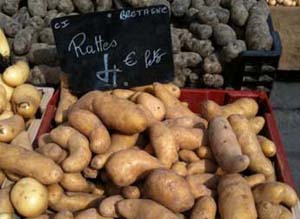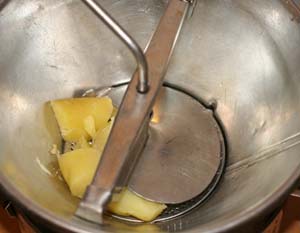Science of cooking perfect mashed potatoes
--AND, HOW TO MAKE ROBUCHON STYLE POTATOES
HOW TO MAKE SUPER-RICH POTATO PUREE
Adapted from from L'Atelier of Joël Robuchon and Ingredients: NOTES ON BUTTER QUANTITY: The classic Robuchon mashed potatoes, as is served at the L'Atelier de Joël Robuchon uses a ratio of potatoes:butter = 2:1. However in Robuchon's book written by Patricia Wells which was targeted for American audiences, the ratio is given as 4:1. If you go with the 2:1 ratio, don't plan on large portions. Just a few table spoons will satisfy most
|
The Ratte is a small potato with a unique nutty flavor and smooth, buttery texture. The variety originated in France or Denmark in the late 19th century. It is the potato preferred by Chef Joël Robuchon for making his mashed potatoes. The potatoes are now also grown in the US. |
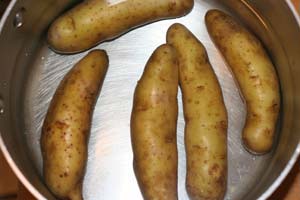 |
Scrub the potatoes (shown to left are Ratte's from Union Square Market) Do not peel the potatoes. Cook them in their skins covered by at least 1 inch of water. For each liter of water add 10 grams of salt. Simmer uncovered over moderate heat for 20-30 minutes or until a knife can easily be inserted and removed. As soon as the potatoes are done remove and drain. Do not allow them to sit in the water. Meanwhile, bring the milk just to a boil in a medium sized saucepan and set aside. |
Once potatoes are cool enough to handle (but still hot), peel them and cut into manageable pieces. Then pass the potatoes through the grid of a food mill (or use a potato ricer) passing them into a large heavy bottomed saucepan |
 |
Discard the skin after it has been peeled away. Place the pan over low heat and using a wooden spatula stir the potatoes to dry them out (approximately 4-5 minutes). Begin adding 3/4 of the butter, little by little vigorously stirring until the butter is incorporated. This should be done in a similar manner as one prepares any butter emulsion (starting off with a very small amount of butter to start the emulsion). |
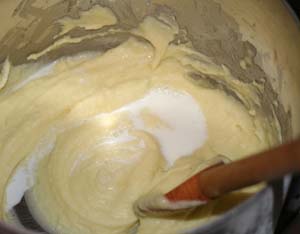 |
Slowly add the milk in a thin stream (a little at a time) till the desired consistency is reached. You may only need a very small amount of the milk, depending on the potatoes used, amount of butter used, and personal taste. Stir vigorously till all the milk is incorporated. Then stir the puree with a whisk to incorporate air and make the puree fluffy. |
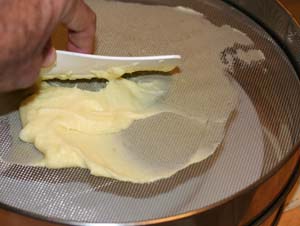 |
Pass the puree through a fine drum sieve to further lighten and smooth the dish. This can be repeated 2 or 3 times for to make the puree silky smooth. Taste for seasoning. If not using immediately, place in the top of a double boiler over simmering water. Whisk occasionally to keep smooth. The puree can be further adjusted with hot milk or butter before serving. |
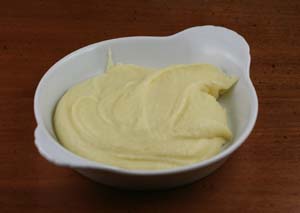 |
If you don't serve the potatoes immediately you can keep them warm for an hour using a double boiler. Remember because they are so rich you only need a small amount per person.
|
Robuchon became famous with his mashed potatoes. Most of the rich velvety style we find in great restaurants use similar or variations of the techniques shown above
Tips and Notes:
Reminder: 1 Tablespoon = 14 grams = 100 calories
Use a food mill or ricer. Passing your mashed potatoes through a food mill or potato ricer will give them a silky smooth texture. You want to limit the amount of mechanical stress to prevent damage to the potato cells. This will prevent the potatoes from becoming gooey... Why do they become gooey? As Harold McGee says: "The gooeyness develops when you break open the cooked potato cells and literally beat the starch out of them. That’s why the consistency is a lot like a cornstarch-thickened sauce."
Dry the potatoes before adding butter. After passing through a food mill or potato ricer it's best to dry the potatoes out for a few minutes. You want to remove as much water as possible. Water is no friend to potatoes..water will cause the starch granules to swell, break down and release some of their contents into the water allowing for gelatinization.
Add enough butter! The number one reason why mashed potatoes made by some restaurants will taste better than yours is because they mix in an enormous amount of butter. Try using from 4:1 --> 2:1 potato:butter by weight. You might want to experiment with the ratios to see the difference.
Use French or European style butter. They have less water and higher fat content.
Robuchon adds the butter first until the mashed potatoes reach their desired consistency, and then add the hot milk to add body and texture to the butter/potato emulsion.
Note: Some chefs believe that melting the milk, cream and butter together before adding them to their mashed potatoes allows the fat to coat the starch granules of the potatoes more evenly, giving it a better texture.
Season your potatoes well with plenty of kosher salt.
Keep the emulsion warm so it will not separate. Too hot or too cold and an emulsion can break.
Notes about Starch in Potatoes:
Starch granules contain two types of molecules amylose, which is linear, and amylopectin, which is branched. These starch molecules have the ability to form gooey molecules, gels or emulsions, In cold water starch does not dissolve:amylopectin is highly insoluble in water, and amylose is soluble only in water temperature about 131. When put in hot water, the water molecules dissolve the amylose molecules and alter the structure of the starch granule causing the granule to swell and break. Boiled potatoes left in water will start to jellify and may even increase in volume, becoming swollen and watery. If a potato puree is watery, it will become sticky. That is why it is important to dry out the potatoes are cooking.
When potatoes meet milk, on the other hand, the starch reacts differently. Mashing or pureeing potatoes with milk, cream or butter, all of which contain several types casein proteins. Casein reduces the quantities of amylose that leaks out of starch granules, and also limits the swelling of the starch, leading to a smoother, more pleasing consistency. Casein is an important emulsifying and binding agent. Excellent potatoes can be made with any ratio of milk, butter or cream since all contain casein proteins. Deciding what ratios of each depends upon your personal taste.
-------------
HOW MUCH MILK, BUTTER AND/OR CREAM DO THEY USE IN THEIR MASHED POTATOES:
Thomas Keller -- Bouchon
2 pounds yukon
8 ounces unsalted butter
3/4 cup (ounces) heavy cream
Thomas Keller -- Under Pressure
1 kg. Yukon Gold
200 grams heavy cream, plus more for finishing
200 grams chicken stock
200 grams unsalted butter, plus more for finishing
Gordon Ramsay -- Passion for Flavor
1kg potatoes Desiree or Romano
150ml or 3/4 cup double cream
3 oz, 85 grams unsalted butter
Gordon Ramsay --F Word
400g Maris Piper potatoes, peeled and chopped
100ml full fat milk
100ml whipping cream
100g butter
Note: Chef Ramsay makes and emulsion first with milk, cream and butter then incorporates it with the potatoes.
Grant Achatz --Alinea
2 medium yukon potatoes
200 grams (7.1 oz.) cold butter
100 g (3.5 oz) heavy cream
Variations of Mashed Potatoes:
--David Bouley often substitutes olive oil or a puree of roasted onions for some of the butter.
--Chef Robuchon makes only a few variations: olive oil or goose fat for the butter, and nutmeg or saffron as seasonings.
-- Many chefs use root vegetables like turnips, parsnips or celery root that are added to the potato puree for flavor;
--Peeled garlic cloves can be boiled with the potatoes and mashed at the same time as is pureed roasted garlic is another good addition.
--Onions, shallots or leeks -- chopped and sauteed until they are soft and golden -- are good to fold in at the end.
--Mincings of black truffle with some truffle juice or truffle oil glorify a puree.
-- Grated 'fresh' horseradish and sour cream, folded in at the end, are popular, especially with hearty beef dishes like short ribs.
--Wasabi paste, sold in tubes in many food shops adds a different sharpness and a hint of green.
-- Cheese, especially grated Parmesan or soft goat cheese, can be folded in. Many chefs add their local cheese.
Science of Cooking
See also:
Science of Chocolate

What are the health benefits of Chocolate?
What are the drugs in Chocolate?
